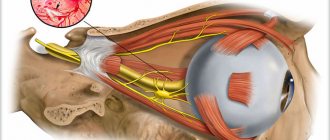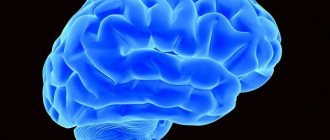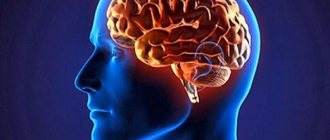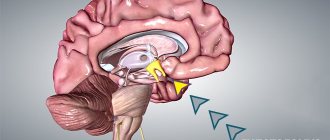E. P. Richardson, M. Flint Beat, J. B. Martin (EPRichardson, M. Flint Beat, JB Martin)
In the classification of diseases of the nervous system, a special group of pathological conditions is distinguished - degenerative, emphasizing that they are characterized by gradual and steadily progressive death of neurons, the causes of which remain not fully disclosed. To identify these diseases, it is necessary to exclude possible etiological factors such as infections, metabolic disorders and intoxications. Clinical practice shows that a significant part of diseases classified as degenerative have a genetic predisposition and are inherited in an autosomal and recessive manner. However, other conditions that are not fundamentally different from hereditary diseases occur only sporadically, in the form of isolated cases in individual families.
Based on the definition, the classification of degenerative diseases cannot be based on an exact knowledge of their causes or pathogenesis. They are divided into various syndromes mainly according to pathological changes, but also taking into account clinical data. Clinically, the group of diseases under consideration manifests itself in the form of several syndromes, the recognition of which helps the doctor in resolving diagnostic issues. In addition to special symptoms that allow one to differentiate one syndrome from another, there are some common signs that characterize the entire group of diseases under discussion.
General remarks
The characteristic features of degenerative diseases are their gradual onset and steadily progressive course over many years, usually longer than with hereditary metabolic diseases affecting the nervous system. The initial changes may be so subtle that it is often impossible to accurately determine the time of their appearance. Sometimes the patient himself or his relatives can report an incident (trauma or some dramatic event) that triggered the onset of the disease. However, upon detailed questioning, it is often possible to find out that the patient or his family members in such circumstances only suddenly become aware of the presence of a disorder that was previously present, but went unnoticed.
Family history is important, but denial of cases of the disease in relatives should not always be taken for granted. One of the reasons is the desire of relatives to hide the presence of neurological pathology in the family. Another circumstance may be a relatively weak susceptibility to the disease in other family members, so that the patient himself and his family members may not be aware of cases of the disease in other relatives; this is, in particular, characteristic of hereditary ataxias. In addition, diagnosis of well-known hereditary diseases is difficult if the family is small. Meanwhile, the familial occurrence of the disease does not always indicate its hereditary nature and in some cases is caused by the influence of a common infectious or toxic factor.
Another common feature of long-term progressive degenerative diseases of the nervous system is that they are resistant to therapeutic interventions. Therefore, the treatment of patients with diseases of this group brings deep disappointment to all those involved in it. However, clinical experience and the necessary knowledge often make it possible to achieve relief of some symptoms, and in some cases, very significant (for example, with Parkinson's disease). Thus, a detailed acquaintance of doctors with this problem can significantly help patients, even if there are no methods that can lead to a cure.
An important feature of the group of diseases under consideration is the tendency towards a bilateral symmetrical distribution of pathological changes, which in itself helps to differentiate them from other forms of neurological disorders. However, in the early stages, only one half of the trunk or one limb may be involved. But sooner or later, despite the asymmetrical beginning, the two-sided nature of the process inevitably reveals itself.
It is noteworthy that diseases classified as degenerative are accompanied by almost selective involvement of certain anatomical and functional neuronal systems, while other structures remain intact. Typical examples are amyotrophic lateral sclerosis, in which the pathological process is limited only to cerebral and spinal motor neurons, and some forms of progressive ataxia, in which only the Purkinje cells in the cerebellum are affected. With Friedreich's ataxia and some other syndromes, many neuronal systems are affected.
In this respect, degenerative neuronal diseases resemble certain pathological processes of known etiology, especially intoxication, which may also be accompanied by selective changes in the nervous system. For example, diphtheria toxin causes selective destruction of peripheral nerve myelin, triorthocresyl phosphate affects the corticospinal tracts in the spinal cord and peripheral nerves, and, as will be discussed below, the neurotoxin 1-methyl-4-phenyl-1,2,5,5-tetrahydropyridine (MPTP) leads to local death of nerve cells in the substantia nigra. Selective involvement of certain neuronal systems is not, however, pathognomonic for all degenerative diseases; some of them are characterized by diffuse and non-selective pathological changes. These exceptions, however, do not diminish the significance of damage to certain neuronal systems as a distinctive feature of many diseases of the group under consideration.
The development of a pathological process in the nervous system is characterized by a slow involution of nerve cell bodies with its spread along the nerve fibers, not accompanied by any pronounced tissue reaction or cellular response. At the same time, the death of neurons and their fibers is accompanied by reactive hyperplasia of fibril-forming astrocytes (gliosis). There are no or minor changes in the cerebrospinal fluid (CSF) and, as a rule, consist of a slight increase in protein levels without changes in the content of specific proteins, cell number and other components. Since these diseases inevitably lead to the death of tissue, and not to the formation of new ones, radiographic visualization of the brain, ventricular system and subarachnoid space does not reveal any changes or determines the expansion of the liquor-containing spaces. Thus, the listed negative laboratory results help in distinguishing degenerative diseases from other large classes of progressive diseases of the nervous system - tumors and infections.
Causes and risk factors
The causes of this type of disorder or disease can be multiple, as there are a large number of factors that can influence its occurrence. The origin in question will largely depend on the neurodegenerative disease we are talking about. However, in most cases, the specific causes of these pathologies are unknown.
Among the many possible causes that are suspected for some of them who know, some causes are found in viral diseases that are not yet curable and affect the nervous system - the presence of changes in the autoimmune system that generate that attack the body's cells.
Clinic, diagnosis and treatment of tauopathies
Among the diseases of this group it is worth highlighting the following pathologies:
- Alzheimer's disease.
- Corticobasal degeneration.
- Pick's disease.
Of the tauopathies, the most widespread is Alzheimer's disease, which begins with subtle manifestations such as memory deterioration and the speed of assimilation of new knowledge and skills, ending with gross impairment of cognitive functions with loss of the ability to self-care.
The diagnosis is established based on characteristic symptoms, as well as on the basis of neuroimaging methods such as magnetic resonance imaging. There are few drugs used to treat this pathology - several drugs from the group of cholinesterase inhibitors and one drug from the group of NMDA antagonists.
Pick's disease is characterized by atrophy of the cerebral cortex, especially the temporal and frontal lobes. The symptoms are similar to those of Alzheimer's disease, but this disease is more malignant and less treatable.
With corticobasal degeneration, atrophy of the cerebral cortex is also observed, but in a slightly different location. This pathological process primarily affects the basal ganglia and substantia nigra. Hypokinetic-rigid syndrome, sensory function disorders, myoclonus, as well as a number of other manifestations are characteristic, which are usually used to establish the diagnosis (a puncture is usually not performed).
Prion diseases
Symptoms of neurodegenerative brain diseases can be quite varied in the case of prion diseases. This group of diseases is caused by a unique pathogen - it is not a viral, bacterial agent or genetic pathology, it is a pathological protein (which means these are the only pathogens that do not contain nucleic acids).
Among these diseases are:
- Kuru.
- Fatal familial insomnia.
- Creutzfeldt-Jakob disease.
Creutzfeldt-Jakob disease is characterized by disorders of the extrapyramidal system, dementia, which is characterized by very rapid progression, epileptic seizures, visual and speech disorders.
In fatal familial insomnia, the abnormal protein is deposited in areas of the brain responsible for regulating sleep. This leads to gradually progressive sleep disorders, and in the later stages the patient completely loses the ability to sleep. At this time, hallucinations and weight loss occur.
Kuru primarily affects the natives of New Guinea; the pathological protein spreads thanks to the ritual cannibalism existing in the tribes. The disease begins with nonspecific complaints, but as it develops, tremors appear throughout the body and coordination of movements is impaired. Once obvious symptoms appear, patients live up to one year.
Trinucleotide diseases
This is a group of hereditary diseases, the most common of which are:
- Huntington's chorea.
- Friedreich's ataxia.
- Spinocerebellar ataxia.
In the case of these diseases, the onset of the disease is gradual. With Huntington's chorea, specific hyperkinesis, as well as various mental disorders, attract attention. The diagnosis is confirmed by magnetic resonance imaging, as well as genetic research, which is informative for all diseases of this group. This disease is incurable, it is only possible to reduce the manifestations of Huntington's chorea.
Friedreich's ataxia is considered the most common of the hereditary ataxias. Characterized by disturbances in walking, handwriting, and weakness in the lower extremities. Gradually, these manifestations are accompanied by muscle atrophy, starting from the lower extremities and gradually spreading.
With spinocerebellar ataxia, a gradual loss of coordination of movements occurs, which is primarily noticeable in walking disorders. Cerebellar atrophy often develops. Nootropics, muscle relaxants and anticonvulsants are used for treatment, but this disease is incurable.
Symptoms
Neurodegenerative diseases manifest themselves regardless of gender and age. The first symptoms may be noticeable only 5-25 years after the onset of neuronal death in the brain. Before this, the brain uses additional mechanisms and reserves to maintain the functions of dead nerve cells. As brain diseases become exhausted, the first warning signs begin to show in the form of the following manifestations:
- decrease in higher brain functions (memory, attention, speech, intelligence, sensitivity, etc.);
- decreased cognitive function, dementia;
- movement disorders, loss of coordination;
- hallucinations;
- disturbance of nervous regulation by the autonomic nervous system;
- mental and neurological disorders.
Possible reasons
The prognosis for neurodegenerative diseases is significantly influenced by a fairly large number of factors. However, the main thing is the characteristics of the course of the disease in a particular patient, as well as how the pathological process responds to the treatment.
There is no specific prevention of diseases of this group, however, researchers have still discovered certain patterns that, in some diseases, reduce the risk of their development, or provide a later onset of the disease and a more favorable course with slow progression.
For example, in the case of Alzheimer's disease, active intellectual activity is a kind of prevention. It is also worth noting the role of a balanced diet and physical activity, which prevents atherosclerosis and thereby reduces the risk of developing neurodegenerative diseases.
Neurodegenerative diseases of the brain are a group of slowly progressive diseases that ultimately lead to disability. Early detection of the problem allows you to maintain a satisfactory quality of life for as long as possible.
This once again emphasizes how important it is to monitor your health and promptly consult a doctor with complaints about changes that are occurring, because they may turn out to be symptoms of serious diseases.









